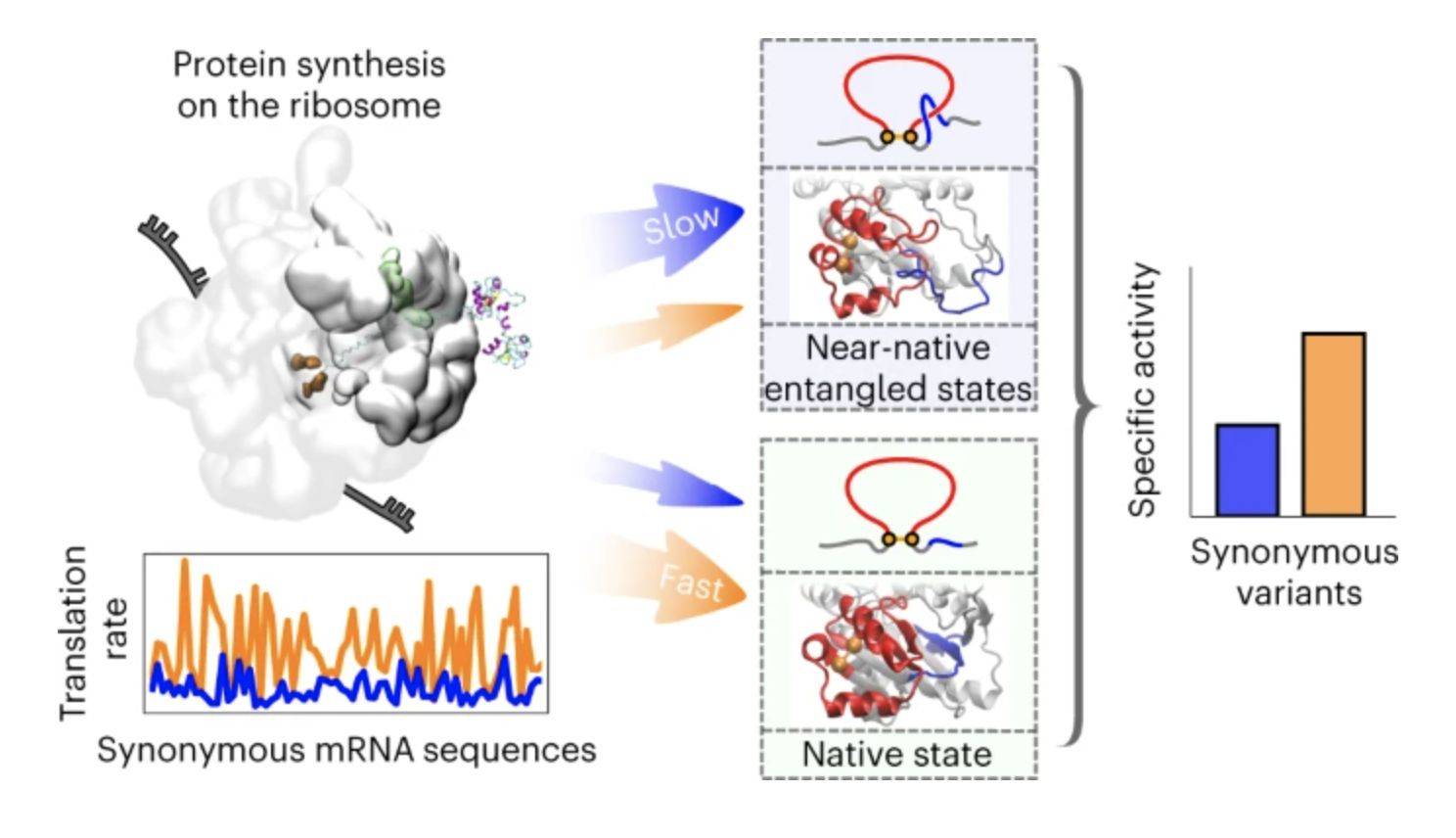Enzyme Mutant Construction involves precise modifications to enzyme gene sequences, playing a vital role in Enzyme Gene and Plasmid Synthesis. Its significance lies in producing enzymes tailored for specific purposes, enhancing properties, and enabling new functions. This procedure empowers us to create enzymes with improved characteristics and design those capable of entirely new functions.
 Synonymous mutations alter enzyme structure and function over long timescales (Wei Gu, et al., 2015)
Synonymous mutations alter enzyme structure and function over long timescales (Wei Gu, et al., 2015)
Service Process
Our comprehensive and methodical process, which we've designed with a meticulous attention to detail and a commitment to thoroughness, is outlined below in a detailed manner for your convenience and understanding:
- Initial Consultation and Project Design: We begin with a comprehensive consultation to understand your unique needs, requirements, and expectations. This step helps us design the project in a way that aligns with your goals, ensuring your satisfaction.
- Mutation Design: After defining the project parameters, our team of genetic experts designs the intended mutation. This process is meticulously managed to ensure optimal results.
- Laboratory Creation of Mutant DNA Sequence: Next, we transition to the lab where the mutant DNA sequence is created. This process, conducted under strict quality control standards, ensures precision and adherence to the highest scientific standards.
- Insertion of Mutant DNA into a Plasmid: Following the creation of the mutant DNA sequence, it is inserted into a plasmid. This step is crucial as it allows us to introduce the mutant DNA to the target organism in a controlled manner.
- Introduction of Plasmid into the Organism: The plasmid, carrying the mutant DNA, is safely introduced into the organism. Our team ensures this operation is conducted effectively and under strict controls.
- Verification of Successful Mutation: After introducing the mutant DNA into the organism, we verify the successful integration of the mutation and the integrity of the results.
- Delivery of Final Product: Upon confirming the success of the mutation and passing all quality checks, we prepare the final product for delivery. We are committed to delivering high-quality results efficiently, aiming to exceed your expectations.
We're here to assist you. If you have any questions, need more information, or would like to discuss a potential project, please don't hesitate to contact us. Our team is always eager to help and share our expertise.
Applications
| Application |
Description |
| Biotechnology |
Enzyme mutant construction plays a crucial role in biotechnology for enhancing enzyme properties such as stability, activity, and specificity for industrial applications. This includes fields like biofuel production, pharmaceuticals, and bioremediation. By engineering enzymes through mutagenesis techniques, researchers can develop variants with improved performance, making them more suitable for large-scale production processes and environmentally friendly applications. |
| Drug Development |
Enzyme mutant construction is pivotal in drug development for creating tailored enzymes that serve as targets for drug discovery or as therapeutic agents themselves. This involves engineering enzymes involved in disease pathways, such as kinases, proteases, or metabolic enzymes, to modulate their activity or specificity. By designing selective inhibitors or activators against disease-associated enzymes, researchers can develop novel drug candidates with improved efficacy and reduced side effects. Enzyme mutants may also be utilized as therapeutic proteins for enzyme replacement therapy or as biocatalysts for prodrug activation in targeted drug delivery systems. |
| Protein Engineering |
Enzyme mutant construction is utilized in protein engineering to modify enzyme structures and functions for specific applications. This involves rational design or directed evolution approaches to improve catalytic efficiency, substrate specificity, and stability. Through site-directed mutagenesis or random mutagenesis coupled with high-throughput screening, scientists can create enzyme mutants with enhanced properties tailored to meet the demands of diverse industries, including healthcare, agriculture, and biotechnology. |
| Agricultural Biotechnology |
Enzyme mutant construction is employed in agricultural biotechnology for developing enzymes that improve crop yield, disease resistance, and nutrient uptake. This includes enhancing enzymes involved in plant metabolism, stress response, and defense mechanisms. By genetically engineering crops to express specific enzyme variants, scientists aim to enhance their adaptability to changing environmental conditions, increase productivity, and reduce reliance on chemical inputs, contributing to sustainable agriculture and global food security. |
| Food Industry |
Enzyme mutant construction finds applications in the food industry for improving food processing efficiency, quality, and shelf-life. This involves engineering enzymes to enhance flavor, texture, and nutritional content or to enable novel food production processes. By tailoring enzymes to target specific substrates or reactions, food technologists can optimize manufacturing processes, develop healthier and more sustainable food products, and meet consumer demands for clean-label ingredients and functional foods. Enzyme mutants also play a crucial role in the production of food additives, such as enzymes used as processing aids or preservatives, ensuring product safety and compliance with regulatory standards. |
FAQs
Here are some frequently asked questions and answers about Enzyme Mutant Construction, covering topics from the explanation of the process, its necessity, practical applications, and more. If you have more specific or detailed questions, don't hesitate to get in touch with us directly.
Q: Can you provide a brief explanation of what Enzyme Mutant Construction is?
A: Absolutely! Enzyme Mutant Construction is a highly specialized technique that involves the precise alteration of gene sequences that code for enzymes. These alterations, commonly referred to as mutations, are not random. Instead, they are intentionally and carefully designed to produce enzymes with specific, desirable traits that can aid in various applications in the fields of biotechnology and pharmaceuticals.
Q: Could you elaborate on why Enzyme Mutant Construction is necessary for Enzyme Gene and Plasmid Synthesis?
A: Certainly! Enzyme Mutant Construction plays a crucial role in the Enzyme Gene and Plasmid Synthesis process. This is primarily because it allows for the creation of enzymes with bespoke properties. These properties are tailored to suit specific applications, thereby offering a higher degree of control and precision in the final enzyme product than can be achieved through traditional methods.
Q: Could you give a detailed explanation of the process involved in Enzyme Mutant Construction?
A: Of course. The process of Enzyme Mutant Construction is complex and involves several steps. The first step is to design the desired mutation. Once this is done, the next step involves creating the mutant DNA sequence that corresponds to this mutation. This mutant DNA is then inserted into a plasmid, which is a small DNA molecule within a cell that is physically separated from chromosomal DNA and can replicate independently. The final step involves introducing the plasmid, which now carries the mutant DNA, into the organism where it will produce the desired enzyme.
Q: Can you give examples of how Enzyme Mutant Construction can be applied in practical scenarios?
A: Enzyme Mutant Construction has a wide array of practical applications. For instance, it can significantly contribute to the field of drug discovery, providing a pathway to create novel enzymes that can lead to the development of more effective medications. It also has applications in the field of biofuel production, where it can lead to the creation of enzymes that can more efficiently convert biomass into biofuel. Additionally, it can be used in environmental remediation efforts, providing a way to create enzymes that can help break down environmental pollutants.
Q: Can you explain the technical route involved in Enzyme Mutant Construction?
A: The technical route of Enzyme Mutant Construction involves a sequence of carefully executed steps. These steps are: 1) Designing the desired mutation, 2) Creating the mutant DNA sequence, 3) Inserting the mutant DNA into a plasmid, and 4) Introducing the plasmid into the organism. Each step requires specialized knowledge and expertise to ensure successful execution.
Q: Can you elaborate more on the potential applications of Enzyme Mutant Construction?
A: Absolutely. In the realm of drug discovery, Enzyme Mutant Construction can be instrumental in creating more effective and targeted treatments by producing enzymes that can interact with specific biological targets. In terms of biofuel production, it can facilitate the development of more efficient and sustainable energy sources by creating enzymes that can efficiently convert biomass into biofuel. Furthermore, in the field of environmental remediation, Enzyme Mutant Construction can help develop effective solutions that can manage and even reduce pollution by creating enzymes capable of breaking down various pollutants.
Q: How can I get started with Enzyme Mutant Construction?
A: If you're interested in starting with Enzyme Mutant Construction, the first step would be to get in touch with us. We can discuss your specific needs and guide you through the process, providing you with the necessary knowledge and resources.
Q: How long does the entire process of Enzyme Mutant Construction take?
A: The duration of the Enzyme Mutant Construction process can vary quite a bit. It can take anywhere from several weeks to several months, depending on the complexity of the desired mutation and the specific requirements of the project.
Q: What is the cost of implementing Enzyme Mutant Construction?
A: The cost of implementing Enzyme Mutant Construction can differ based on a variety of factors. It largely depends on the complexity of the desired mutation, the specific requirements of the project, and the resources available.

































 Synonymous mutations alter enzyme structure and function over long timescales (Wei Gu, et al., 2015)
Synonymous mutations alter enzyme structure and function over long timescales (Wei Gu, et al., 2015)